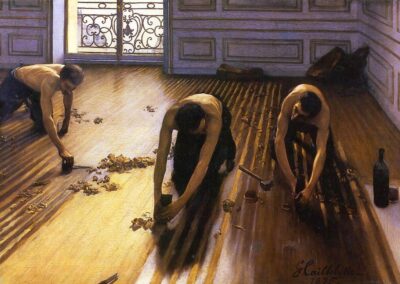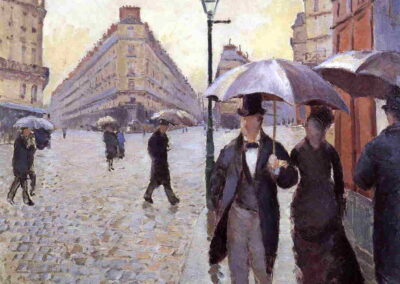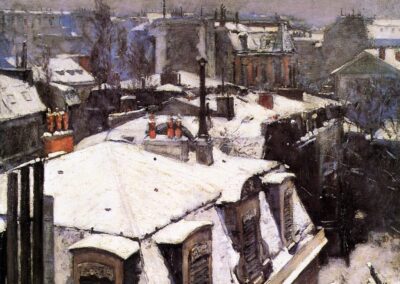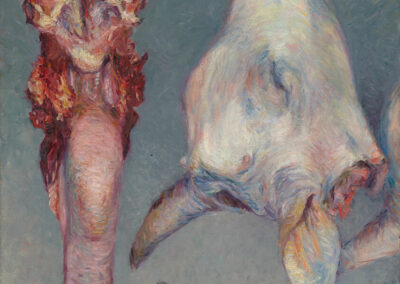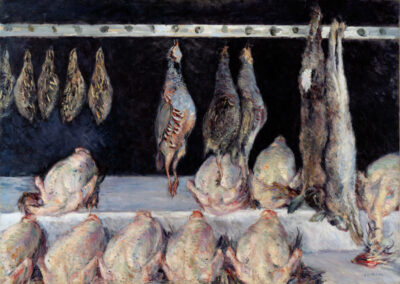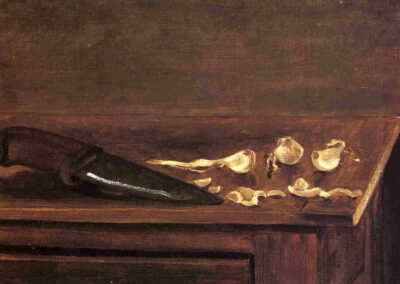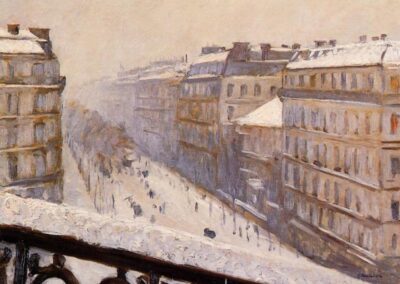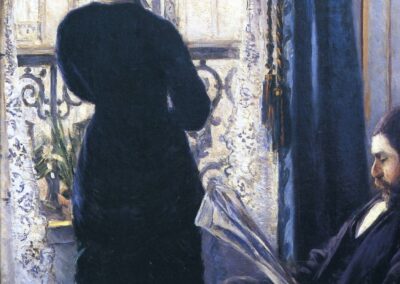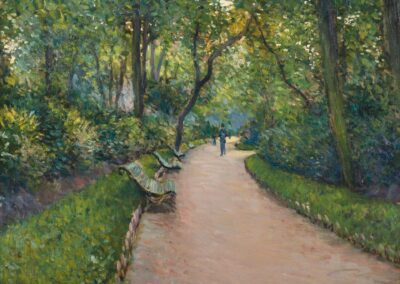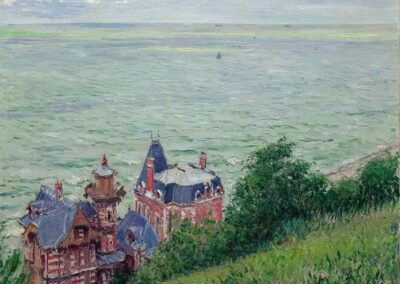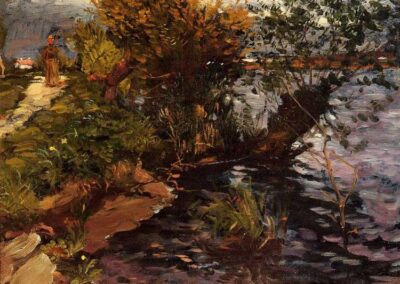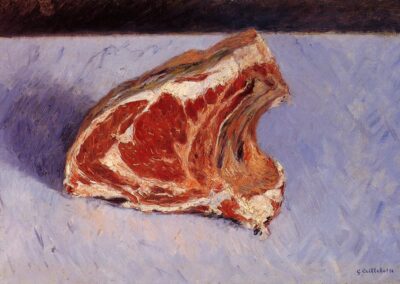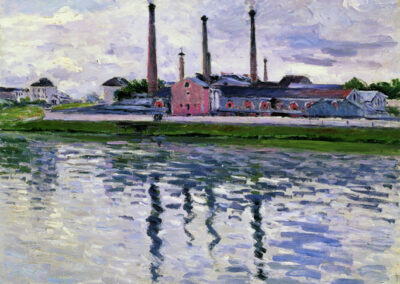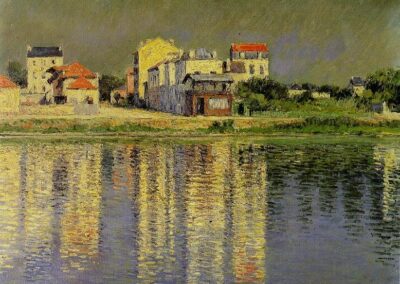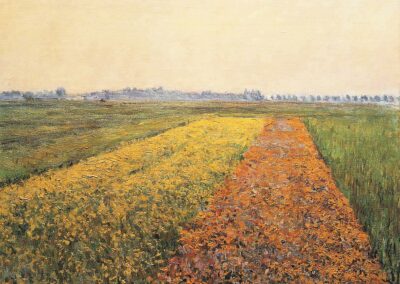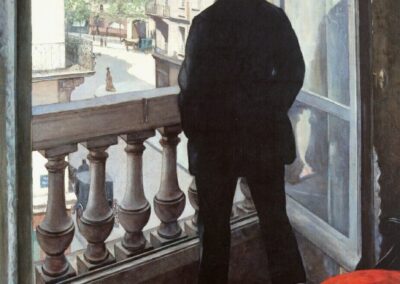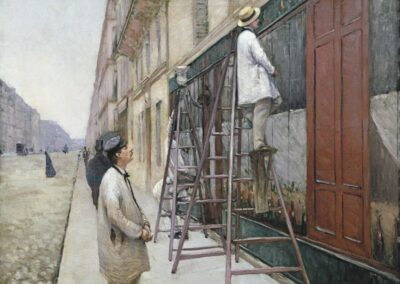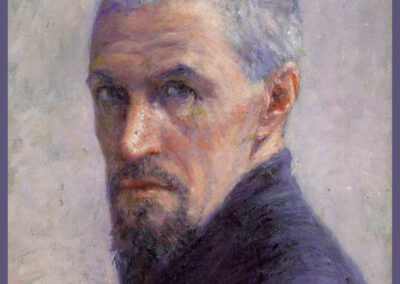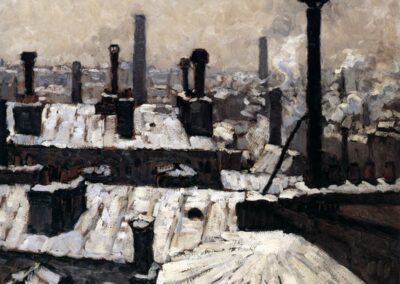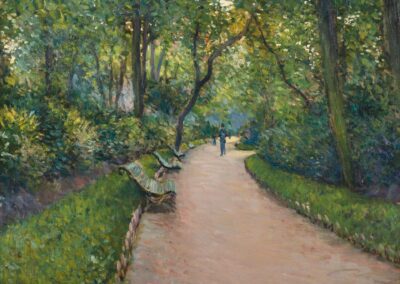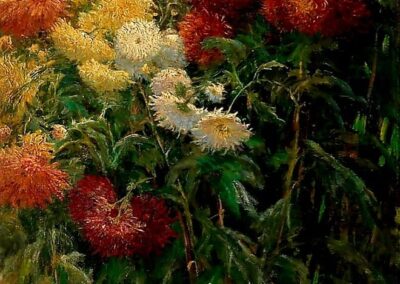The next Artist You Need To Know is Gustave Caillebotte (1848 – 1894).
Caillebotte was a French painter most often associated with the French Impressionists, though his style was in a more realistic sphere than many of the others in that group. The common ground he truly shared with this group was his interest in depictions of everyday life, rather than more formal and arguably rigid academic subjects. One of Caillebotte’s most famous and praised works – The Floor Scrapers – was refused acceptance in the Paris Salon, dismissed as any “depiction of working-class people in their trade was a vulgar subject matter.”
His early interest in photography as an art form was also groundbreaking. A prolific artist, Caillebotte produced street scenes, still life compositions and portraits that are among the best of his era and that still move viewers today with their use of colour and his melding of medium and social history.
“The very great artists attach you even more to life.”
Born into a wealthy family in Paris in 1848 (textiles and later real estate), Caillebotte was the eldest of three children : they often summered at their estate in Yerres (which he would often paint, later in life) and it was there, at a young age, that he began to draw and paint. Caillebotte obtained a law degree in 1868, a license to practice two years later, but he also trained as an engineer. Not long after leaving school, Caillebotte was drafted into the Franco-Prussian War : he served from July 1870 to March 1871.
After the war, he turned to his artistic practice with energy and enthusiasm : a major influence was the painter Léon Bonnat who was a teacher at the prestigious École des Beaux Arts and numbered among his friends the writer Émile Zola and artists Edgar Degas and Édouard Manet. Bonnat also was a teacher to an impressive list of artists that would revolutionize painting in both Europe and in the United States over the ensuing decades, including Henri de Toulouse-Lautrec, John Singer Sargent, Thomas Eakins, Georges Braque, Jean Beraud, and Edvard Munch.
Caillebotte began to attend the École des Beaux-Arts in 1873 but was rarely there in person, preferring to work at the studio he had at his family’s home.
In 1874, his father died, and his brother would pass two years later and his mother two years after that. This tragedy did result in Caillebotte and his sole surviving sibling dividing a significant inheritance between them (this would allow Caillebotte to be a patron to many artists later in his life). He also became part of a circle of artists who eschewed the French Academy – some of the most important avant-garde artists of this period – counting among his friends individuals like Claude Monet, Pierre-Auguste Renoir, Camille Pissarro, and Giuseppe De Nittis.
Caillebotte began to exhibit with the Impressionists in 1876 and he often assisted with organizational and financial support for the group. He often was a major patron for artists within the group, whether buying their work or even paying their rents when they were unable to do so. Caillebotte was extremely generous on this front.
But his tastes were evident in what he collected and whom he sponsored : Caillebotte was uninterested in the works of Seurat or Gauguin, nor any of the Symbolist artists. However, he was the driving force in convincing the Louvre Museum to acquire Manet’s Olympia (1963), which was one of his more controversial artworks. He was also a a philatelist, as his first rate stamp collection was another of his passions, and is now in the collection of the British Library in London.
From here : “By the time of the third Impressionist exhibition in 1877, Caillebotte had become not only a central organizer of what had evolved into an independent, unofficial, and distinctly avant-garde salon, but he was also an important force in the avant garde movement, although his style didn’t explore the effects of light. His work was more Realist, on par with early paintings by Monet, as well as the work of Gustave Courbet and Édouard Manet. He displayed work in subsequent Impressionist exhibitions, although he famously boycotted the sixth one as he had opposed the inclusion of Degas, a rivalry that underlines how fraught associations in the Impressionist circle actually were. He participated the following year, in the seventh Impressionist exhibition, submitting 17 paintings, although there was turmoil once again as, evidently, Caillebotte and Pissarro were at odds, a situation that Monet mediated with some success. Monet and Caillebotte both refused to participate in the final exhibition in 1886 but, by then, he had all but stopped painting completely.”
Caillebotte retired from painting around this time, and would relocate permanently to Petit-Gennevilliers in 1988. He focused primarily on further expanding his art collection, gardening and building yachts : his remaining brother Marcel – and the painter Renoir – were frequent visitors. Caillebotte never married and had no children.
His painting career was all but done by the early 1890 : Caillebotte passed away in 1894 – at the very young age of 45 – in Gennevilliers, France. He succumbed to pulmonary congestion (but it may also have been a stroke) while working in his garden.
Fittingly (not just for his own work but for his nurturing and support of the visual arts in France), Caillebotte was interred at Pere Lachaise Cemetery in southeastern Paris.
His estate bequeathed his collection to the French State but had a proviso (that they would have to wait two decades for them) to ensure that they would be able to display them in the manner fitting the works: “I give to the French State the paintings which I have; nevertheless, since I want that this donation be accepted and in such a manner that the paintings go neither in an attic nor in a provincial museum, but…in the Luxembourg Museum and later in the Louvre Museum, it is necessary that a certain time passes before execution of this clause…”
In contrast to the role he played in bringing the works of many significant artists to the attention of both the public and various institutions, Caillebotte’s own works were primarily ignored during his lifetime. As he did not need to sell his works, as his financial status was secure during his lifetime, many of his artworks were inherited by relatives or within the collections of friends. Most art historians considered him a patron and benefactor, essential to the rise of Impressionism and subsequent schools, but not often spending any time or thought upon Caillebotte’s own paintings.
It would be nearly a century after his death – seven decades, to be exact – when Caillebotte began to garner praise and recognition for his own art. Spaces such as the Art Institute of Chicago, New York’s Museum of Modern Art and numerous other sites have been at the forefront of positioning Caillebotte as a worthy and important painter whose “depictions of Paris life struck a chord with the public and he is now recognised as a key figure within the evolution and development of Impressionism.” (from here)
Major retrospectives of his work were organized by The National Gallery of Art (Washington, D.C.) and the Kimbell Art Museum (Fort Worth, Texas) in 2015–2016
Currently, a massive overview of Caillebotte’s art titled Gustave Caillebotte: Painting His World (organized by the Art Institute of Chicago, the Musée d’Orsay in Paris, and the J. Paul Getty Museum in Los Angeles) is soon to open in Chicago. This touring exhibition has offered a new focus on Caillebotte’s depictions of men, in moments of leisure, and posited some new interpretations of his work that focus on his sexuality.
More about Gustave Caillebotte can be learned here and here.

